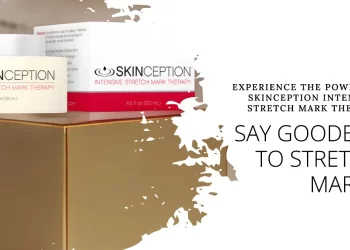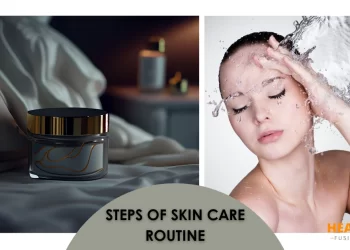Deep stretch marks can be a common concern for many individuals, affecting both men and women. In this section, we will explore the importance of understanding these marks and delve into their definition. By gaining a clearer understanding of what deep stretch marks are and why they matter, we can arm ourselves with the knowledge to effectively address this common skin issue.
| Key Takeaways |
| Deep stretch marks can be caused by hormonal changes and the use of corticosteroids. |
| Risk factors for developing deep stretch marks include rapid weight gain, pregnancy, and genetic predisposition. |
| Laser therapy and certain home remedies or over-the-counter treatments can be effective in reducing the appearance of deep stretch marks. |
Importance of Understanding Deep Stretch Marks
Stretch marks can be super concerning. It’s important to understand what they are and how they impact us. They appear as deep grooves or indentations in the skin, often caused by rapid weight gain or loss, pregnancy, puberty, or medical conditions. Knowing the causes and effects of deep stretch marks helps us manage and treat them.
To learn more about Deep Stretchmarks: Causes and Treatments, visit this reputable source.
Hormones have a big role in deep stretch marks – particularly during puberty and pregnancy. Corticosteroids, like those used for eczema or asthma, can also cause them. Knowing this helps us identify potential risks and take preventative measures.
The look and effects of deep stretch marks vary. People with a family history of stretch marks, or who have had big weight changes, are more likely to get them. Over time, some stretch marks fade, while others become more noticeable. This emphasizes the need for constant monitoring and management.
Dive into the mysterious world of stretch marks, where bizarre beauty awaits!
Definition of Deep Stretch Marks
Deep stretch marks, also known as striae distensae, are skin conditions caused by stretching and tearing of the middle layer of the skin.
These marks often appear on areas such as the abdomen, thighs, buttocks, and breasts. They usually appear as indented streaks or lines, varying in color from pink/red to purple or even white. They feel grooved or depressed when touched.
Hormonal changes in the body can weaken the elastic fibers in the skin, making it more prone to stretching and tearing. Corticosteroids, used in asthma or inflammation, can also weaken collagen and elastin fibers.
Risk factors include pregnancy, rapid weight gain or loss, genetics, and certain medical conditions affecting hormones. Over time, the lines may fade to white scars or become less noticeable.
Treatments include laser therapy, moisturizers/oils, over-the-counter creams containing retinol/hyaluronic acid, and professional treatments like microdermabrasion/chemical peels.
Prevention strategies involve exercising to keep the skin toned and hydrated, drinking enough water, and using professional treatments.
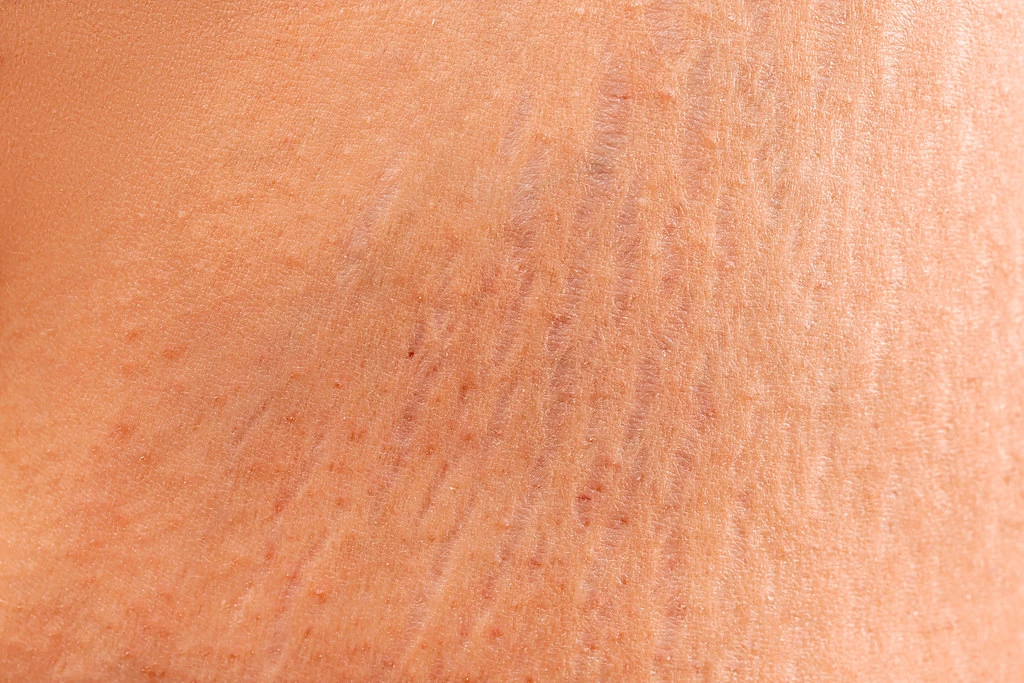
Causes of Deep Stretch Marks
Stretch marks can be caused by various factors, and in this section, we will explore two key contributors. First, we will uncover the influence of hormones on the development of deep stretch marks, shedding light on the physiological processes involved. Then, we’ll examine the role of corticosteroids and their impact on the formation of deep stretch marks. By understanding these causes, we can gain insights into effective treatments and prevention strategies.
Influence of Hormones on Deep Stretch Marks
Hormones play a major part in forming deep stretch marks. During puberty, pregnancy, and certain medical conditions, hormones like estrogen and progesterone alter the skin’s elasticity. This can cause it to become less resilient and more likely to stretch, leading to the formation of deep stretch marks.
Corticosteroids can also affect the development of stretch marks. They weaken collagen fibers in the skin, causing more stretch marks to form. People with hormonal imbalances may be more prone to developing them.
To better understand and treat deep stretch marks, it is important to consider hormone levels during different life stages and health conditions. You can talk to a healthcare specialist to get personalized advice and find treatments that reduce the appearance of deep stretch marks. Don’t let them stop you from feeling confident – take action today!
Role of Corticosteroids in the Development of Deep Stretch Marks
Corticosteroids, hormones from the adrenal glands, have been linked to stretch marks. These hormones affect the skin’s structure and function, which can lead to deeper stretch marks.
This is especially true in medical conditions that cause increased corticosteroid production, like Cushing’s syndrome. People who take oral or topical corticosteroids for a long time can also be at risk.
The way corticosteroids cause deep stretch marks isn’t clear. But, it’s thought they weaken the collagen and elastin fibers in the skin. This can create indented lines on the skin’s surface.
To find effective treatments and prevention, the role of corticosteroids must be understood. Interventions can be developed to manage deep stretch marks due to corticosteroid use or elevated hormone levels.
Effects and Appearance of Deep Stretch Marks
Stretch marks can have noticeable effects on our skin and appearance. In this section, we explore the factors that contribute to the development of deep stretch marks and how they can change over time. By understanding the risk factors involved and the transformations that occur, we gain valuable insights into managing and treating these stubborn marks.
Risk Factors for Developing Deep Stretch Marks
Deep stretch marks on the skin can be caused by various risk factors. These can include hormonal influences, corticosteroid use, lifestyle choices, and genetic predisposition. Prolonged sun exposure and a history of stretch marks may also contribute.
To avoid deep stretch marks, individuals should keep a balanced diet, exercise regularly, and moisturize their skin. Laser therapy can help reduce existing deep stretch marks. Knowing about the associated risks is key to preventing and treating deep stretch marks.
Changes in Deep Stretch Marks Over Time
Deep stretch marks change significantly over time. This is because of hormones and corticosteroids. Hormones make the collagen and elastin fibers in the skin weak. This causes red or purple marks on the skin.
If left alone, the marks fade from red or purple to a lighter, silvery hue. Deep stretch marks don’t vanish on their own, though. The texture can also change, becoming less raised or indented.
As the stretch marks age, they become harder to treat. Professional treatments are necessary. Also, lifestyle changes can help prevent new stretch marks and improve skin health. By keeping your skin nourished and moisturized, you can stop new stretch marks and make existing ones less noticeable. Check out the Deep Stretchmarks: Causes and Treatments for more information.
Data on treatments for deep stretch marks: Laser therapy and home remedies are the real heroes here! They beat those stubborn marks.
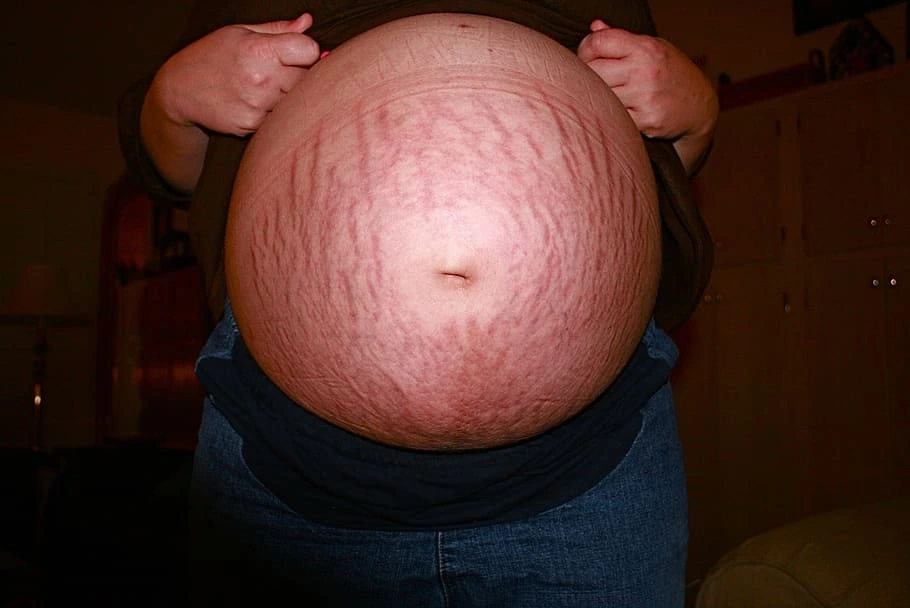
Latest Data on Treatments for Deep Stretch Marks
Discover the latest data on treatments for deep stretch marks, including laser therapy and home remedies. Uncover the effectiveness and benefits of these treatment options for reducing the appearance of deep stretch marks. The article will provide valuable insights into how these treatments work and their impact on improving skin conditions.
Laser Therapy as a Treatment Option
Laser therapy is a good choice for treating deep stretch marks. It uses laser beams to target and reduce the marks’ visibility. The laser emits certain wavelengths of light onto the area, which helps increase collagen production and brings about skin renewal. By improving the color and texture of the marks, laser therapy can make them less visible over time.
The amount of treatments needed may vary based on the size and seriousness of the stretch marks. There could be short-term side effects, say, redness or minor soreness during the procedure. Though, these usually disappear shortly after.
To learn more about Deep Stretchmarks: Causes and Treatments, visit this reputable source.
While laser therapy can be efficient, it may not take away deep stretch marks fully. It is best suited for individuals with light to moderate stretch marks, not those with extreme scarring. It is advisable to seek advice from a dermatologist or healthcare provider before going through laser therapy for deep stretch marks.
Tip: To get better results, laser therapy can be combined with other treatments, such as topical creams or home remedies.
Home Remedies and Over-The-Counter Treatments for Deep Stretch Marks
Tackle deep stretch marks with some home remedies! Natural oils like almond oil or coconut oil, can be applied. Buy over-the-counter creams or lotions, with ingredients like hyaluronic acid or retinol. Collagen production can also be increased – to improve skin texture. Moisturize the skin to make it more elastic, and lessen the appearance of stretch marks.
Exfoliate regularly too! Make a scrub with ingredients like sugar or coffee grounds, mixed with a carrier oil. This will help remove dead cells and promote new cell growth – for healthier and smoother skin.
However, home remedies and OTC treatments may only show some improvement – only partially eliminating the deep stretch marks. In more severe cases, laser therapy or micro-needling might be necessary to get good results. Consult with a dermatologist, before starting any treatment for deep stretch marks.
Prevention and Managing Deep Stretch Marks
Prevent and manage deep stretch marks with effective lifestyle changes and professional treatments. Discover practical ways to avoid these marks and explore the options available for effectively treating them.
Lifestyle Changes to Prevent Deep Stretch Marks
Deep stretch marks can be stopped by making changes to your lifestyle. These modifications can help to reduce the chances of developing deep stretch marks and keep skin healthy. Here is a 4-step guide on how to adjust your lifestyle to prevent deep stretch marks:
- Hydrate your skin: Keeping it hydrated is key for its elasticity and health. Drink enough water throughout the day. Also, use moisturizers or oils made for stretch marks to keep your skin moisturized on the outside.
- Have a balanced diet: Eating nutritious food can promote skin health and stop deep stretch marks from forming. Eat foods with vitamins A, C, and E which are important for creating collagen and supporting skin elasticity.
- Manage weight gain: Gaining weight during pregnancy or quickly can lead to deep stretch marks. Take care of your weight gain by doing exercises that are okayed by your doctor.
- Protect your skin from the sun: UV rays can weaken collagen fibers in your skin, making it more likely to get deep stretch marks. Wear sunscreen with SPF and stay in the shade when the sun is strongest.
These steps could help you lower the chances of getting deep stretch marks and maintain healthier-looking skin. It is important to remember that preventing deep stretch marks needs a combination of lifestyle changes like proper hydration, nutrition, weight management, and sun protection. Doing these things can help your skin stay soft and reduce the appearance of deep stretch marks.
Professional Treatments for Managing Deep Stretch Marks
Various professional treatments can help manage deep stretch marks. One is laser therapy, which uses light energy to stimulate collagen production and promote healing. It can fade the color and make them less visible.
Micro-needling is another option. It uses tiny needles to create micro-injuries, which trigger the body’s natural healing response. This leads to improved skin texture and reduced stretch marks.
Chemical peels or dermabrasion exfoliate the top layers of skin. This encourages new cell growth and improves overall skin tone. Injectable fillers can also be used to plump up depressed areas.
Consult with a qualified dermatologist or skincare specialist to assess your needs and recommend suitable treatments. Don’t miss out on effectively managing your deep stretch marks. Book a consultation today and take control of your confidence!
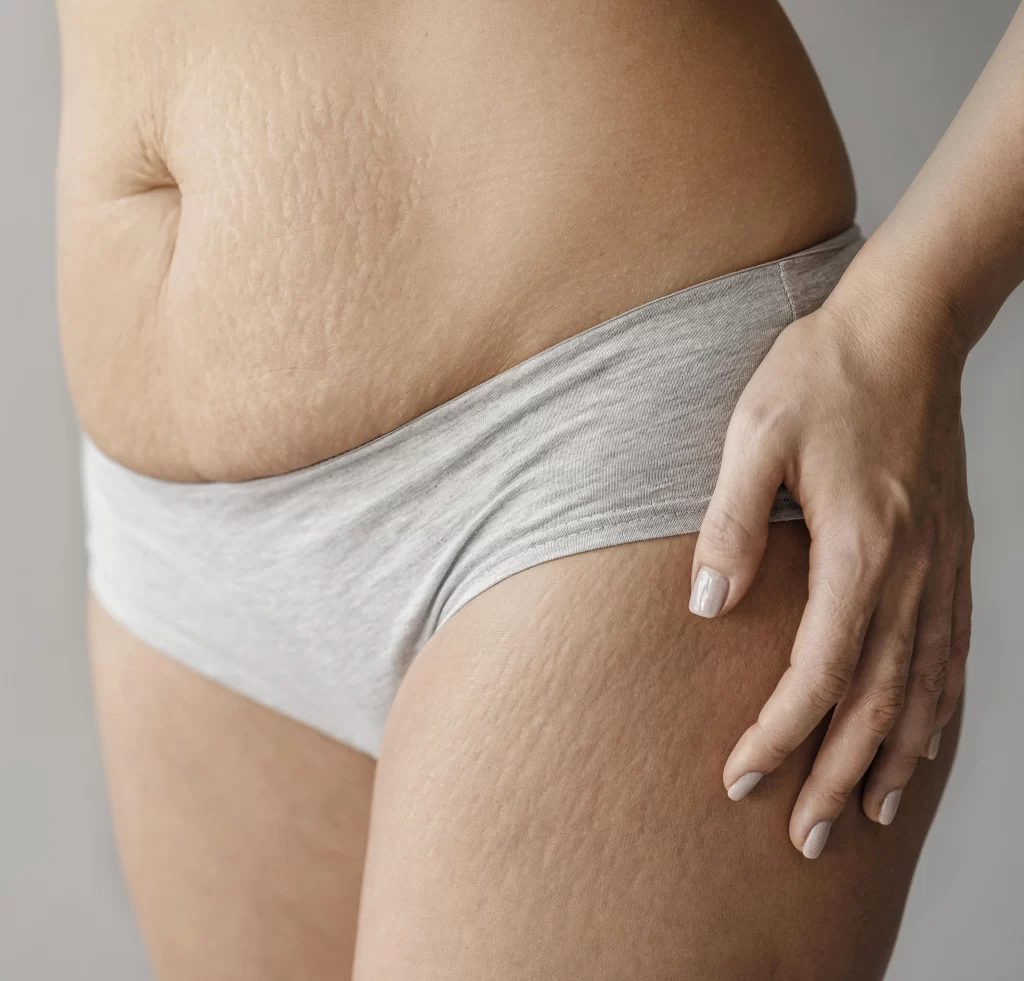
Last Thoughts
Stretch marks are a regular skin issue. It can be caused by quick weight gain/loss, hormone changes, and pregnancy. It happens when the skin is extended past its elasticity, causing visible lines and streaks.
There’s no cure-all for stretch marks, but there’re treatments that can reduce their appearance.
These treatments include:
- Topical creams
- Laser therapy
- Microdermabrasion
Topical creams with retinol, hyaluronic acid, and vitamin E can help, as they promote collagen production and skin elasticity. Laser therapy uses light energy to boost collagen production. Microdermabrasion involves removing the top layer of dead skin cells.
It’s essential to note that these treatments may help, but they cannot fully eliminate stretch marks. The success depends on the individual and the severity of the marks. To determine the best course of action, talk to a dermatologist or skincare professional.
In summary, stretch marks are common and can be treated with creams, laser therapy, and microdermabrasion. Complete elimination may not be possible, so consulting a skincare professional is advised.
Some Facts About Deep Stretchmarks: Causes and Treatments:
- ✅ Deep stretch marks, also known as striae, are long, rippled marks that develop on the skin when it is stretched or shrinks quickly. (Source: Mayo Clinic, Medical News Today)
- ✅ Stretch marks can appear on various body parts, such as the abdomen, breasts, hips, buttocks, thighs, and arms. (Source: Mayo Clinic, WebMD, Medical News Today)
- ✅ Common causes of deep stretch marks include pregnancy, rapid weight gain or loss, puberty growth spurts, bodybuilding, and certain medical conditions. (Source: Mayo Clinic, WebMD, Medical News Today)
- ✅ Treatment options for deep stretch marks include laser therapy, microdermabrasion, chemical peels, radiofrequency, and ultrasound, but complete elimination may not be possible. (Source: Mayo Clinic, WebMD)
- ✅ While creams, lotions, and home remedies may help minimize the appearance of stretch marks, their effectiveness is not well-established. (Source: Medical News Today, WebMD)
FAQs about Deep Stretchmarks: Causes And Treatments
What are the causes of deep stretch marks?
Deep stretch marks are caused by the stretching of the skin, which can occur due to factors such as pregnancy, rapid weight gain or loss, childhood growth spurts, weight training, and hormonal changes like the hormone cortisol.
How can stress on the skin contribute to the development of deep stretch marks?
Stress on the skin, caused by factors like rapid growth, weight fluctuations, and excessive stretching, can lead to the development of deep stretch marks. When the skin cannot stretch enough to accommodate these changes, the collagen and elastin fibers rupture, resulting in the appearance of stretch marks.
What medical treatments are available to minimize the appearance of deep stretch marks?
Medical treatments for deep stretch marks include options such as fractional CO2 laser therapy, pulsed dye laser therapy, microdermabrasion, chemical peels, radiofrequency, and ultrasound. These treatments aim to stimulate collagen production, improve skin texture, and reduce the visibility of stretch marks.
Can prescription medicine help in reducing the appearance of deep stretch marks?
Prescription medicines like hyaluronic acid and tretinoin have shown some relief in making deep stretch marks less noticeable. These medications can be prescribed by a dermatologist and may help improve the overall appearance and texture of the skin affected by stretch marks.
Is body makeup effective in concealing deep stretch marks?
Body makeup can be used to temporarily conceal deep stretch marks. It can minimize their appearance and blend them with the surrounding skin tone. However, it is important to note that body makeup provides only a cosmetic solution and does not treat or eliminate stretch marks.
How can cocoa butter help with the appearance of deep stretch marks?
While cocoa butter is often touted as a remedy for stretch marks, there is limited evidence to support its effectiveness. While it may help moisturize the skin and improve its elasticity, there is no guarantee that it will prevent or eliminate deep stretch marks. Other medical treatments may be more effective in minimizing their appearance.




